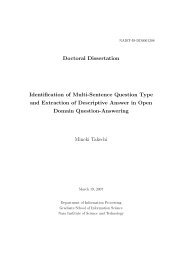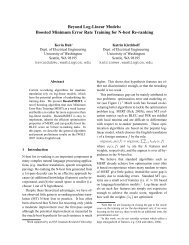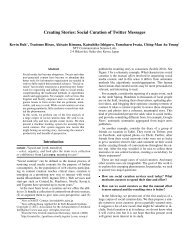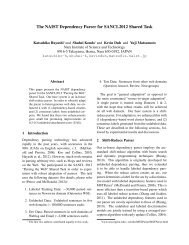Learning to Rank with Partially-Labeled Data - University of ...
Learning to Rank with Partially-Labeled Data - University of ...
Learning to Rank with Partially-Labeled Data - University of ...
Create successful ePaper yourself
Turn your PDF publications into a flip-book with our unique Google optimized e-Paper software.
that Kernel PCA and <strong>Rank</strong>Boost is one such good pair, but<br />
there may well be others.<br />
2.2 Kernel PCA<br />
Principal components analysis (PCA) is a classical technique<br />
for extracting patterns and performing dimensionality<br />
reduction from unlabeled data. It computes a linear combination<br />
<strong>of</strong> features, which forms the direction that captures<br />
the most variance in the data set. This direction is called<br />
the principal axis, and projection <strong>of</strong> a data point on it is<br />
called the principal component. The magnitude <strong>of</strong> the principal<br />
component values indicates how close a data point is<br />
<strong>to</strong> the main directions <strong>of</strong> variation.<br />
Kernel PCA [24] is a powerful extension <strong>to</strong> PCA that<br />
computes arbitrary non-linear combinations <strong>of</strong> features. As<br />
such, it is able <strong>to</strong> discover patterns arising from higher-order<br />
correlations between features. We can imagine Kernel PCA<br />
as a procedure that first maps each data point in<strong>to</strong> a (possibly)<br />
non-linear and higher-dimensional space, then performs<br />
PCA in that space. More precisely, let d be a list <strong>of</strong> m documents<br />
and d j be the original feature vec<strong>to</strong>r <strong>of</strong> document j. 3<br />
Then Kernel PCA can be seen as the following procedure:<br />
1. Map each doc d j <strong>to</strong> a new space d j ↦→ Φ(d j ), where<br />
Φ(· ) is the (non-linear/high-dimension) mapping.<br />
2. Compute<br />
P<br />
covariance matrix in this new space:<br />
C = 1 m<br />
m j=1 Φ(dj )Φ(d j ) T . (T = transpose)<br />
3. Solve the eigen-problem: λv = Cv.<br />
4. The eigenvec<strong>to</strong>rs v <strong>with</strong> the largest eigenvalues λ form<br />
a projection matrix P . <strong>Data</strong>points can now be projected<br />
<strong>to</strong> the principal axes <strong>of</strong> the non-linear space defined<br />
by Φ(· ).<br />
In practice, Kernel PCA uses the dual formulation <strong>to</strong><br />
avoid solving the above eigen-problem in high dimensional<br />
space (this is known as the kernel trick). See [24] for the<br />
derivation; here we only present the steps needed for this<br />
paper:<br />
1. Define a kernel function k(· , · ) : (d j , d j′ ) → R which<br />
maps two document vec<strong>to</strong>rs <strong>to</strong> a real number indicating<br />
the similarity between the two documents.<br />
2. There exist kernels <strong>of</strong> the form<br />
k(d j , d j′ ) = 〈Φ(d j ), Φ(d j′ )〉, (i.e. dot product <strong>of</strong> the<br />
document mappings in high-dimensional space) such<br />
that the mapping does not need <strong>to</strong> be computed explicitly<br />
<strong>to</strong> get the kernel value.<br />
3. Let the m × m matrix K be the kernel values <strong>of</strong> all<br />
pairs <strong>of</strong> documents in the list. i.e. K jj ′ = k(d j , d j′ )<br />
∀j, j ′ ∈ {1, 2, . . . , m}.<br />
4. Kernel PCA reduces <strong>to</strong> solving the eigen-problem mλα =<br />
Kα. We pick only the α <strong>with</strong> the largest eigenvalues.<br />
5. For a new document d n , its principal component is<br />
computed as P m<br />
j=1 αjk(dj , d n ).<br />
The kernel function defines the type <strong>of</strong> non-linear patterns<br />
<strong>to</strong> be extracted. In this work, we use the following kernels:<br />
• Polynomial: Computes dot product <strong>of</strong> all monomials<br />
<strong>of</strong> order p, k(d j , d j′ ) = 〈d j , d j′ 〉 p .<br />
3 In the context <strong>of</strong> Kernel PCA, we drop the subscript in<br />
d u <strong>to</strong> avoid clutter. d u or d is a document list; d j is one<br />
document vec<strong>to</strong>r <strong>with</strong>in the list.<br />
• Radial basis function: k(d j , d j′ ) = exp (− ||dj −d j′ ||<br />
).<br />
2σ<br />
This is an isotropic kernel, <strong>with</strong> bandwidth σ adjusting<br />
for smoothness.<br />
• Diffusion kernel [15]: This is suitable for graph data.<br />
We generate a k-nearest neighbor graph <strong>with</strong> documents<br />
as nodes and edges defined by the inverse Euclidean<br />
distance 1/||d j − d j′ ||. k(d j , d j′ ) is defined<br />
by running a lazy random walk from d j <strong>to</strong> d j′ . A<br />
time-constant parameter τ adjusts how long <strong>to</strong> run<br />
the random walk (e.g. larger τ leads <strong>to</strong> a more uniform<br />
distribution). Performing Kernel PCA <strong>with</strong> diffusion<br />
kernels is equivalent <strong>to</strong> running PCA on a non-linear<br />
manifold.<br />
• Linear: k(d j , d j′ ) = 〈d j , d j′ 〉. Equivalent <strong>to</strong> PCA.<br />
Kernel PCA scales as O(m 3 ), due <strong>to</strong> solving the eigenproblem<br />
on the m × m kernel matrix K. Nevertheless,<br />
extremely fast versions have been proposed; for instance,<br />
Sparse kernel feature analysis [26] is based on sparsity constraints<br />
and can extract patterns in O(m).<br />
2.3 <strong>Rank</strong>boost<br />
<strong>Rank</strong>Boost[8] is an extension <strong>of</strong> the boosting philosophy<br />
[23] for ranking. In each iteration, <strong>Rank</strong>Boost searches for a<br />
weak learner that maximizes the (weighted) pairwise ranking<br />
accuracy (defined as the number <strong>of</strong> document pairs that<br />
receive the correct ranking). A weight distribution is maintained<br />
for all pairs <strong>of</strong> documents. If a document pair receives<br />
an incorrect ranking, its weight is increased, so that next iteration’s<br />
weak learner will focus on correcting the mistake.<br />
It is common <strong>to</strong> define the weak learner as a non-linear<br />
threshold function on the features (decision stump). For example,<br />
a weak learner h(· ) may be h(d j ) = 1 if“BM25 score ><br />
1” and h(d j ) = 0 otherwise. The final ranking function <strong>of</strong><br />
<strong>Rank</strong>Boost is a weighted combination <strong>of</strong> T weak learners:<br />
F (d j ) =<br />
TX<br />
θ th t(d j ),<br />
t=1<br />
where T is the <strong>to</strong>tal number <strong>of</strong> iterations. θ t is computed<br />
during the <strong>Rank</strong>Boost algorithm and its magnitude indicates<br />
the relative importance <strong>of</strong> a given weak learner (feature).<br />
Finally, a ranking over a document list d is obtained by<br />
calculating y j = F (d j ) for each document and sorting the<br />
list by the value <strong>of</strong> y j .<br />
There are several advantages <strong>to</strong> using <strong>Rank</strong>Boost <strong>with</strong><br />
Kernel PCA in our transductive framework:<br />
1. Inherent feature selection: <strong>Rank</strong>Boost selects T features<br />
that are most conducive <strong>to</strong> good rankings. Since<br />
there are no guarantees that the Kernel PCA’s directions<br />
<strong>of</strong> high variance always correspond <strong>to</strong> directions<br />
<strong>of</strong> good ranking, <strong>Rank</strong>Boost’s inherent feature selection<br />
reduces the need for tuning. For a LEARN() algorithm<br />
<strong>with</strong>out inherent feature selection (e.g. <strong>Rank</strong>SVM),<br />
we may have <strong>to</strong> tune for (a) number <strong>of</strong> Kernel PCA<br />
features, (b) relative importance <strong>of</strong> Kernel PCA features<br />
compared <strong>to</strong> original features.<br />
2. Non-linear thresholding in weak learners h(· ): One<br />
could define the weak learner <strong>to</strong> be simply the feature<br />
values (e.g. h(· ) = raw BM25 score). This assumes<br />
that good ranking is directly correlated <strong>to</strong> the feature<br />
values (e.g. large BM25 implies more relevance). Kernel<br />
PCA, however, may generate features that have










